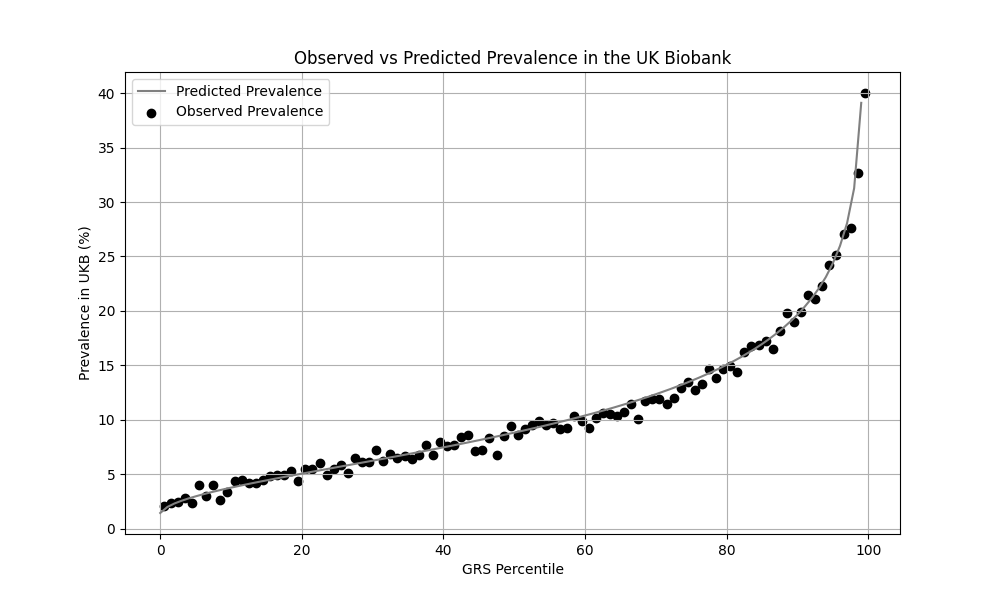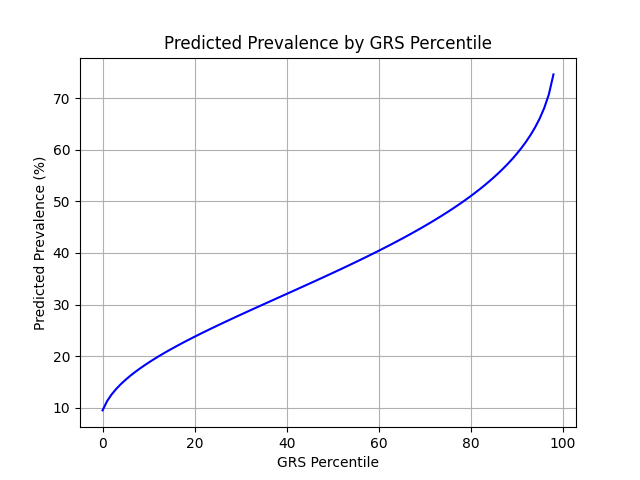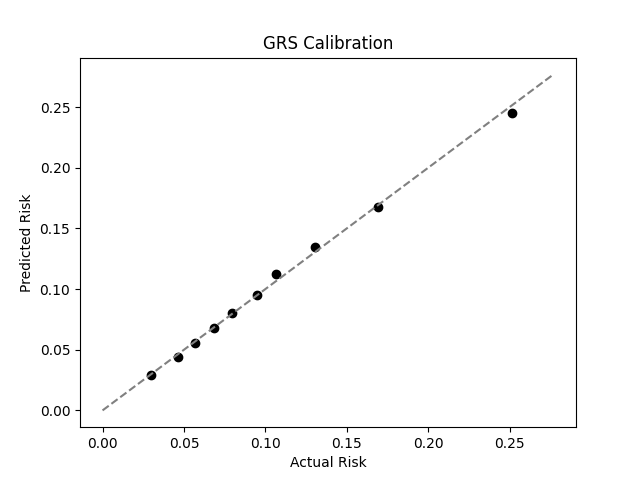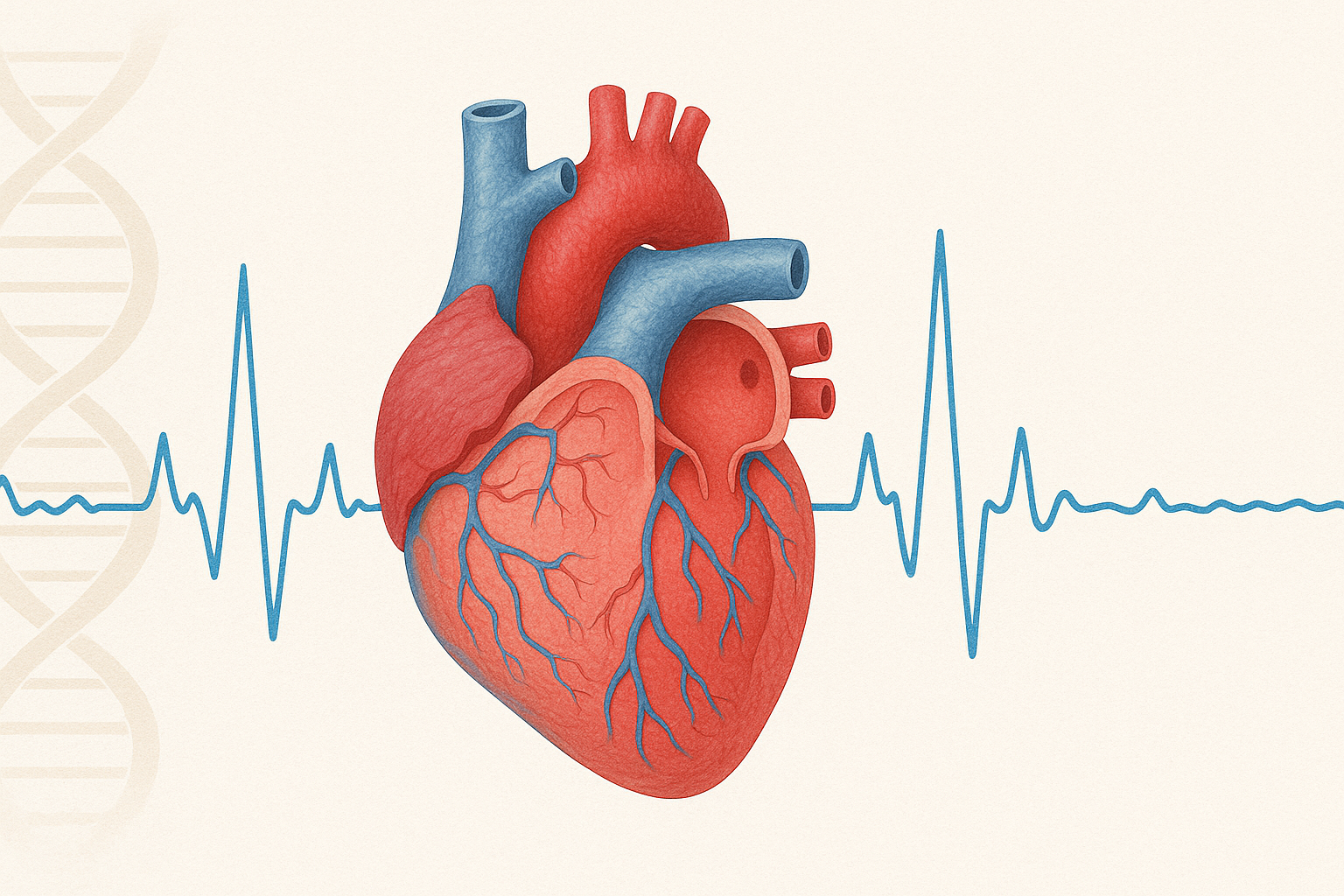Orchid's team of genetic experts has developed a genetic risk score (GRS) for atrial fibrillation.
Written by Orchid Team
Orchid has developed advanced genetic risk scores (GRS) for a variety of diseases. Here we present our data on our GRS of atrial fibrillation.
Atrial Fibrillation
Atrial fibrillation is a common cardiac arrhythmia in which the atria beat rapidly and irregularly. It can cause palpitations, dizziness, shortness of breath, and fatigue. Age is the primary risk factor, but hypertension, diabetes, and obesity also increase susceptibility. It can be triggered by binge drinking or elevated stress. Atrial fibrillation can lead to serious complications, including a 5x risk of stroke.[1][2]
Genetic Risk Score
Atrial fibrillation is shaped by both environmental and genetic factors. Monogenic testing is not available because no single gene causes the condition. Genetic risk scores (GRS), which combine the small effects of many variants into a single score, are currently the only way to estimate genetic risk. Although not diagnostic, a GRS can indicate how likely an individual is to develop the disease.
Orchid’s atrial fibrillation GRS was trained following current industry standards.[3][4] The GRS was constructed using the SBayesRC algorithm trained on publicly available FinnGen and Million Veterans Program summary statistics.[5][6] The summary statistics include 151,410 cases and 778,364 controls.[7] The resulting GRS contains over a million variants.
Risk predictions are adjusted to each individual’s ancestry, with predictive power decaying as genetic distance from the predominately European training data increases.[8] Orchid considers a GRS meaningfully predictive if individuals at roughly the 97.7th percentile have an odds ratio (OR) of 2. The atrial fibrillation GRS meets this criteria for all common ancestry groups.
Clinical Impact and Prevalence
Atrial fibrillation is the most common form of cardiac arrhythmia and is projected to affect up to 12.1 million Americans by 2030.[9] A family history of atrial fibrillation is associated with a 40% increased risk.[2] It is estimated that 37.1% of individuals over the age of 55 will develop atrial fibrillation during their lifetime.[10]
Treatment is complex and may include medications to slow heart rate, prevent arrhythmia, and prevent stroke complications. Surgical options are rare and include catheter ablation and pacemaker implantation.[2][11]
Performant Risk Stratification
We evaluated the predictive performance of Orchid’s atrial fibrillation GRS using the UK Biobank (UKB), a research database of roughly 500,000 genotyped individuals from the United Kingdom. We restricted the analysis to participants of British ancestry aged 55 or older and defined atrial fibrillation as any diagnoses under ICD-10 codes I48.x, yielding 26,093 cases and 233,099 controls (10.1% prevalence). We then grouped individuals by GRS percentile and compared the observed disease prevalence within each group to our model’s predictions (Figure 1). For additional technical details, see the Supplementary Data.

UKB participants tend to be healthier than the general population, which leads to lower observed disease prevalence.[12] Weng et al. estimate a 37.1% lifetime risk of atrial fibrillation for individuals over age 55, much higher than the prevalence in the UKB.[10] We adjust our model so that its average predicted risk aligns with this estimate (see Figure 2).[13] People at the tail end of the GRS distribution were at an elevated risk compared to the mean (see Table 3), with adults in the 99th percentile 2.0x more likely to develop atrial fibrillation than average (74.6% vs 37.1%).

References
1. Wolf PA, Abbott RD, Kannel WB. Atrial fibrillation as an independent risk factor for stroke: the Framingham Study. Stroke. 1991 Aug;22(8):983–8. doi:10.1161/01.STR.22.8.983.
2. Brundel BJJM, Ai X, Hills MT, et al. Atrial fibrillation. Nat Rev Dis Primers. 2022;8:21. doi:10.1038/s41572-022-00347-9.
3. Moore S, Davidson I, Anomaly J, et al. Development and validation of polygenic scores for within-family prediction of disease risks. medRxiv. 2025. doi:10.1101/2025.08.06.25333145.
4. Cordogan S, Starr DB, Treff NR, et al. Within- and between-family validation of nine polygenic risk scores developed in 1.5 million individuals: implications for IVF, embryo selection, and reduction in lifetime disease risk. medRxiv. 2025. doi:10.1101/2025.10.24.25338613.
5. Zheng, Z., Liu, S., Sidorenko, J. et al. Leveraging functional genomic annotations and genome coverage to improve polygenic prediction of complex traits within and between ancestries. Nat Genet 56, 767–777 (2024). https://doi.org/10.1038/s41588-024-01704-y
6. FinnGen. FinnGen+MVP+UKBB Summary Statistics. Available at: https://mvp-ukbb.finngen.fi/about. Accessed 2025-12-05.
7. FinnGen. FinnGen+MVP+UKBB Phenotypes. Available at: https://mvp-ukbb.finngen.fi. Accessed 2025-12-05.
8. Privé, Florian et al. “Portability of 245 polygenic scores when derived from the UK Biobank and applied to 9 ancestry groups from the same cohort.” American journal of human genetics vol. 109,1 (2022): 12-23. doi:10.1016/j.ajhg.2021.11.008
9. CDC. Atrial Fibrillation. 15 May 2024 [cited 5 Dec 2025]. Available: https://www.cdc.gov/heart-disease/about/atrial-fibrillation.html
10. Weng LC, Preis SR, Hulme OL, et al. Genetic predisposition, clinical risk-factor burden, and lifetime risk of atrial fibrillation. Circulation. 2018;137:1027–1038. doi:10.1161/CIRCULATIONAHA.117.031431
11. January CT, Wann LS, Calkins H, et al. 2019 AHA/ACC/HRS Focused Update of the 2014 AHA/ACC/HRS Guideline for the Management of Patients With Atrial Fibrillation. Circulation. 2019;140:e125–e151. doi:10.1161/CIR.0000000000000665.
12. Fry A, Littlejohns TJ, Sudlow C, et al. Comparison of sociodemographic and health-related characteristics of UK Biobank participants with those of the general population. Am J Epidemiol. 2017;186:1026–1034. doi:10.1093/aje/kwx246.
13. Chatterjee N, Shi J, García-Closas M et al. Developing and evaluating polygenic risk prediction models for stratified disease prevention. Nat Rev Genet. 2016;17:392–406. doi:10.1038/nrg.2016.27
Supplementary Figures



Acknowledgements
This research has been conducted using the UK Biobank Resource under Application Number 80545.







